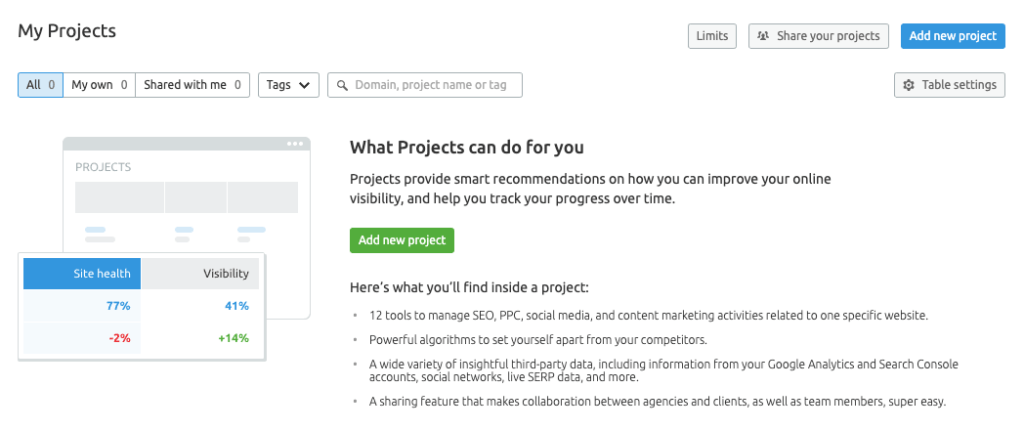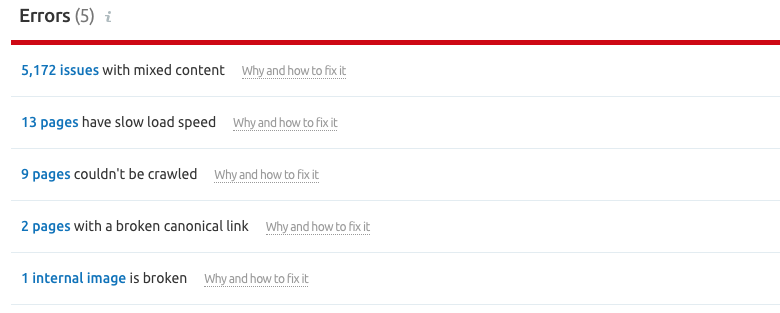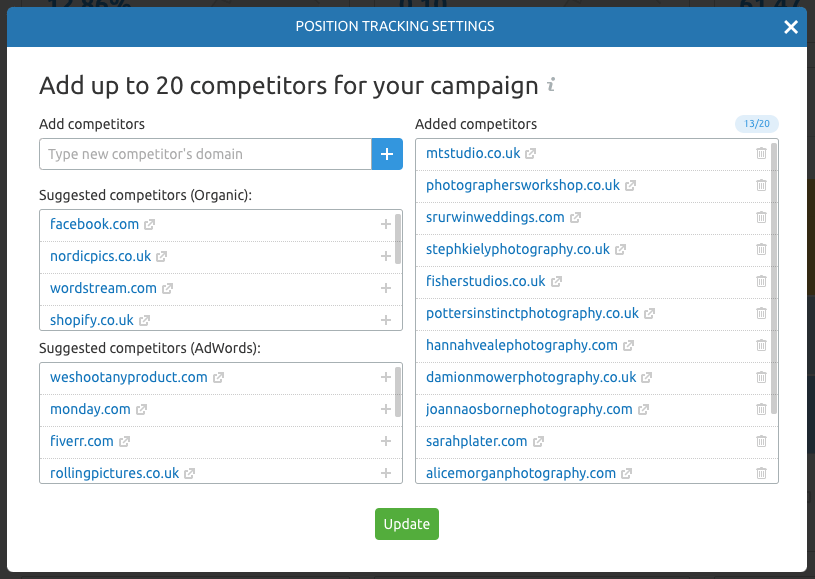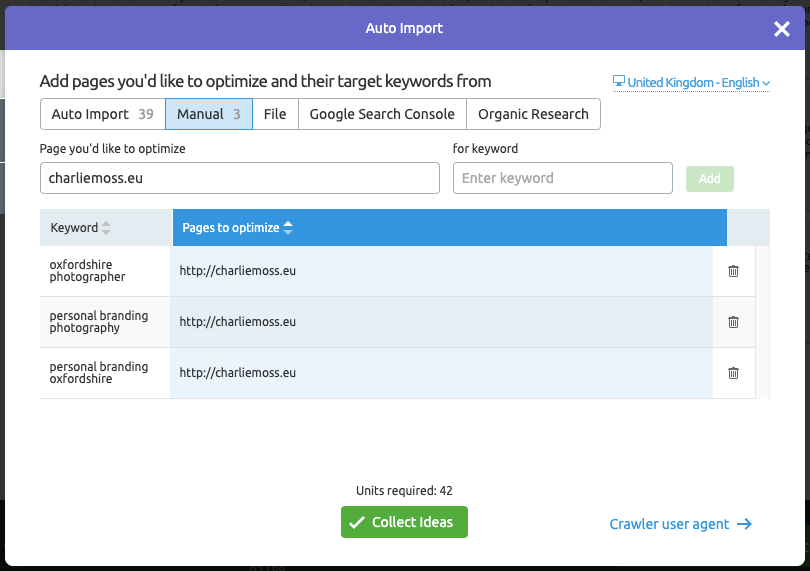
07 Nov SEO for Photographers: How to Get Started with SEMRUSH
We can all remember how it felt to learn a tool for the first time. Understanding layers in Adobe Photoshop? It look me weeks. Well SEMrush is no different. It’s a highly specialised tool that has great potential to help you in your photography business. SEO for photographers can be tricky business, but with it’s help you can improve your site and find guidance on which areas of your web presence and marketing need a little extra attention.
But SEMrush is a big, unwieldy beast. It’s built for social media professionals who really know what they’re doing. So how can you get your head around SEMrush when you’re a photographer? The same way you’d eat an elephant – one bite at a time!
Sign up for a SEMrush account
First things first, you’re going to need an account. Head over to Semrush and sign up for their seven day free trial. The SEMrush free trial allows you to do everything a basic paid account would do, so you really get to experience the tool and discover if it’s going to be what you need to improve your website rankings. They offer lots of step by step advice in the reports that is great for SEO for photographers.
Once you’re in, check out the side bar for the “dashboard option. You’re probably all there, but just in case you’re not it’s in the “management” section on the left hand side. Scroll down until you find “My Projects.”

Your project is where you manage everything to do with your personal website and domain. It allows you to generate and run regular reports and keep tabs on some of the historic data to do with your websites SEO rankings. So go ahead and enter your domain name and give your project a name.
Once you’ve added your project here you’ll see a table with a series of boxes that say “set up.” You’ll want to work along them one by one setting up all the different aspects of the SEMrush project management tool.
Site Audit
Site Audit is a tool from SEMrush that will scan your website for technical and SEO mistakes. This tool is going to be the foundation of how you improve the content that is already on your site. The Site Audit tool will regularly scan your website and send you email reports letting you know about any mistakes you can fix. Some of these mistakes are real quick fixes, just a few minutes of your time, and they can be extremely beneficial to your SEO rankings.
Set your “limit of checked pages” to a higher number than you think that you have pages on your site. Don’t forget that there can be lots of hidden pages too that you never see. I put it up at 10,000 for mine, even though I know my website doesn’t have anywhere near that amount of pages. You want your crawl source to be your website. Don’t set it to sitemaps or similar unless you have a good reason to do that.
The only other option you might want to consider is your schedule. Schedule your crawl for a low traffic day to your site. I have it set to Monday every week because that’s usually my quietist day.
Once you’re done with configuring the too, click the green “Start Site Audit” button at the bottom and let it start running.

Those are my results. 73% isn’t the worst result it could be, but there really is room for improvement! Lots of the problems are very technical and might be tough for a novice website manager to get into themselves, but there should still be things that you can fix quite easily. Head on over to the “issues” page to see what you might be able to fix quickly. SEMrush provides a handy “why and how to fix it” beside every problem, which can help you on your quest to getting a perfect website. Having a good and well functioning website is key when you’re considering SEO for photographers.

Many of my problems are related to HTTPS protocol, and I think that this is a problem with my WordPress theme. It’s something I’m going to query with the developers of the theme and see if they have any suggestions. I know that my web hosting isn’t very fast either (it hosts several of my websites) and that’s not something I’m going to change right now. Meanwhile, I can see something that I should be able to fix! An internal image is broken – lets check that out.,
It looks like, at some point, I have deleted a photograph from my website that was displayed on one of my gallery pages. It’s a quick and easy fix – I deleted the broken image out of the gallery page it was on. I also made a note in my todo list software that I should go back and review that page with some newer pictures.
One of the big problems flagged up on the “Warning” list of errors was that lots of my pages have a low word count. This is often the case with photographers websites as we think the images can speak for themselves. However Google isn’t really smart enough to interpret the content of a page from its images so it often needs a bit of help. Make sure that you’re adding a couple of paragraphs to each page, and that you’re filling out the description of a page in the metadata. This will make a huge difference to how Google understands your site. Try for 300 words minimum if you can, but something is always better than nothing.
Position Tracking
The Position Tracking tool is a handy little thing. It checks the search rankings of your website, compares it to your competitors, and shows you new ways that you can get into the top Google search results. SEO for photographers relies on understanding what your competitors are up to.
To use this tool you really need to have a think about which keywords you want to rank, and if you want them to be local or national. Many photographers rely on local Google searches to bring them new customers, so this is a great tool for monitor how you’re doing with your local SEO.
I live in quite a small town, so I wanted to look at local county searches. With that in mind I entered my Location as “Oxfordshire” and opted to show local rather than national data.
On the next page you can choose the keywords that you want to monitor. You can always come back to these settings, so don’t worry too much about getting it right first time. Think about the kinds of words that people would use to find your business. For instance if I owned a high street photography studio people might use the terms “pet photographer Oxfordshire” or “wedding photography in Oxford” or “engagement session Oxfordshire.” I’m going to go ahead and enter those terms right know, knowing that I almost certainly won’t rank for them! I added a few more for good measure.

pet photographer Oxfordshire
wedding photography in Oxford
engagement session Oxfordshire
Oxford portrait photographer
Oxfordshire product photography
Pet photography Oxford
Oxfordshire wedding photographer
portrait photos Oxfordshire
branding photography oxford
personal branding oxfordshire
I went ahead and added some more terms that I know I already rank for, just so that I could see how I was comparing to other photographers.
All that’s left to do after you’ve set your keywords to track, is to click the Start Tracking button and let it run the report! After a short amount of time, SEMrush will show you a report telling you what your “rankings distribution” is. This is essentially where the keywords that you’ve entered into the tool rank in Google searches for those terms.
The goal is always to be in the top three for each search term. Anything below top ten and you’re really going to struggle for that keyword to bring you traffic, especially in local searches. Your aim is to improve your rankings over time so that all of your chosen keywords that you want to rank for are appearing in the top three Google search results for that term or phrase.
One of the great features of this SEMrush tool is the ability to add up to 20 competitors. If you look along the top of the Position Tracking report you’ll see the option to add some competitors. If you open this window it’ll suggest websites who rank for the keywords that you entered into the monitoring settings. SEMrush has identified these websites as your competition based on the search terms that you want to rank for. SEO for photographers sometimes requires you to borrow some intel from the competition – don’t be afraid to do it!

You can add up to twenty, but be selective. For instance, SEMrush suggested that I might like to add Digital Photography School as a competitor to monitor, however there really isn’t much point. Not only are they my client (go check out the articles I’ve written for them) but they are such a massive and vast site that it’s going to give me no helpful data because they rank for thousands of keywords. They’re also not a local website, so they’re irrelevant for my local ranking campaign. (But shout out to Oxford Dog Photography who appeared in my suggested list of competitors – I think you have my dream job).
Over time you’ll be able to track your rankings against your competitors. It’ll give you the opportunity to see who is moving up and down compared to your own site, and then you can investigate what they’ve recently changed on their website (perhaps a new blog, or a rewritten ‘about me’ page). This kind of insight is vital for learning how to improve your own site, and capture some of your competitions search traffic. There are lots of reports here to explore in this tool, so make sure you spend some time learning about each one. Keeping an eye on your competitors is key to SEO for photographers.
On Page SEO Checker
This tool allows you to add pages and their target keywords for the tool to analyse and tell you how to improve your SEO for that particular page and keyword combo. You can allow the tool to auto import keywords and pages, but you can also add keywords and pages manually. I suggest using the auto import to improve what you already have (but delete out suggestions that aren’t useful to you) and then add some of your own manual suggestions. Here you can see I’ve added keywords to the manual tab that I would like to rank for but currently don’t. This is also a good time to think about restructuring your website – for instance, it might be better for me to add a new page about personal branding photography, and attempt to rank for that in google searches.

Sure enough, the report has run and it’s given me 81 optimisation ideas and suggestions that I need to optimise all 14 pages that I told it to check. Turns out my SEO maybe wasn’t as good as I thought it was! Just proves that SEO for photographers is tricky!
Do take the time to work through these suggestions, they can really improve your search rankings and can help you analyse your website and make improvements. It’s probably the part of the tool that I use most on other sites because I can log on just for 15 minutes and make a real difference to the search traffic that my website is generating.

The screenshot above shows the report for my homepage, for a search term that I’ve never tried to rank for before. It’s essentially an “idiots guide” to how I can start to rank for the search term that I’ve selected. If I followed all of the advice on this page I would pretty quickly find myself ranking for the term “personal branding Oxfordshire” and potentially rising past my competitors. It’s a step by step tutorial of exactly what you need to do. No guesswork needed.
I particularly like the “Semantic” section further down the page. This part of the tool analyses the ranking data of your rivals and suggests other related keywords to include in your page. Just an extra paragraph or two could provide the kind of information that visitors to your website are looking for, and could also help you rank for those additional search terms too.
Remember that a page doesn’t just have to rank for one search term, it can rank for lots all at the same time! Just don’t stuff your keywords needlessly or write absolute gibberish – Google doesn’t like that and will penalise your site.
What now? SEO for photographers is an ongoing job!
That’s the first three tools in the SEMrush dashboard that are useful to photographers. Already you should be able to enact some serious change just based on the information given to you by these tools. In fact, you could probably spend the whole week of your SEMrush free trial just making the changes suggested by the On Page SEO Checker! It wouldn’t be a bad thing to do, and could improve the volume of traffic driven to your photography site. And what does more traffic mean? More potential customers!
Let me know how you get on in the comments!
Related Posts
AFFILIATE DISCLOSURE
I may earn commissions for any links that appear in blog posts on this site. There is no change in pricing if you click through an affiliate link.





